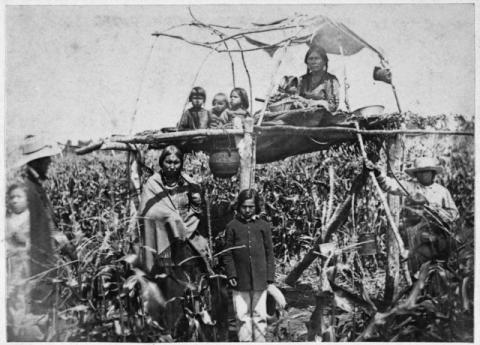Pictograph of corn from the Rosebud Winter Count.
Virtue And Vice Within Ear Of Corn
Personality Traits Revealed At Harvest
By Marie L. McLaughlin
GREAT PLAINS - “The Signs Of Corn" comes from
Marie L. McLaughlin’s “Myths And Legends Of The Sioux.”
When corn[1]
is to be planted by the Indians,[2]
sorting and cleaning the best seed is women’s work, just as it is to plant and
maintain the garden, as it was down in the olden days.
After the
best seed was selected, the planters measured the corn, laid down a layer of
hay, then a layer of corn. Over this corn they sprinkled warm water and covered
it with another layer of hay, they bound the hay into a bundle and hung it up
in a spot where the warm rays of the sun struck it.
While the bundle
hung in the sun, the ground was prepared to receive the corn. Having finished
the task of preparing the ground, the woman took down her seed corn which had
by this time sprouted.
Before she
planted the first mound, she extended her hoe heavenwards and asked the Great
Spirit[3]
to bless her work, that she may have a good yield. After her prayer she took
four kernels and planted one at the north, one at the south, another at the
east and yet again at the west sides of the first hill. This was a formal
petition to the Great Spirit to give summer rain and sunshine to bring forth a
good crop.
Then she planted
her corn.
Dakota women and children guarding corn at the Upper Sioux Agency in Granite Falls, MN, taken the day before the Minnesota Dakota Conflict, by Adrien John Ebell, August 1862.
At harvest
in the fall, the women discern the personality of who planted which corn, by
examining the character of the ears of corn.
1st.
When the kernels grow in straight rows and the cob is full, this signifies that
the planter of this corn is of an exemplary character, and is very truthful and
thoughtful.
2nd.
When the kernels grow in irregular and broken rows, this indicated that the planter
is considered careless, thoughtless, disorderly, and slovenly about her house
and person.
3rd.
When an ear of corn bears a few scattering kernels with spaces producing no
corn, it is said that is a good sign that the planter will live to a ripe old
age. So old will they be that like the corn; their teeth will be few and far
between.
4th.
When a stalk bears a great many nubbins, or small ears growing around a large
one, it is a sign that the planter is from a large and respectable family.
After the
corn is gathered, it is boiled into sweet corn and made into hominy[4];
parched and mixed with buffalo tallow and rolled into round balls,[5]
and used at feasts, or carried by the warriors on the warpath as food.
When there
has been a good crop of corn, an ear is always tied at the top of the medicine
pole, of the sun dance, in thanks to the Great Spirit for his goodness to them in
sending a bountiful crop.
[1] Wagméza: corn or maize.
[2] McLaughlin uses the terms Indian/s and Sioux interchangeably with Dakȟóta (Allies) and Očhéti Šakówiŋ (Seven Council Fires).
[3] Wakȟáŋ Tȟáŋka
(Great Mystery; Great Spirit), Tȟuŋkášila (Grandfather) are generally
used in prayer to address the creator. Wawíčhaȟya
(Creator) is sometimes used.
[4]In those days, corn was soaked in ash
which de-hulled the corn.
[5]
Wasná.



No comments:
Post a Comment